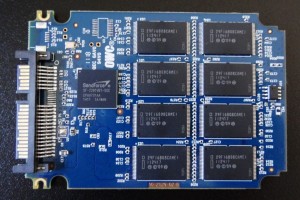A look inside the exterior casing of the OWC Electra was a bit unexpected as many believe that asynchronous NAND flash memory is new to the SSD scene. I knew I recognized this specific ‘strain’ of memory but couldn’t recall it being in any recent SSDs which eventually led to my giving in to a Google search. Back in late 2010, Intel and SandForce had teamed up for the first public display of 25nm NAND flash memory within a prototype SSD at IDF 2010 and Nate Kirsch and LegitReviews caught it first. Its a bit ironic that they, at that time, highlighted this specific 25nm memory, memory that is only now being seen well after a rash of 25nm synchronous NAND flash memory releases.

 The main components of the drive consist of the SATA 3 interface for connecting to a computer, SandForce SF-2281 6Gbps processor and 16 chips of Intel 25nm asynchronous memory.
The main components of the drive consist of the SATA 3 interface for connecting to a computer, SandForce SF-2281 6Gbps processor and 16 chips of Intel 25nm asynchronous memory.
 Each chip has a capacity of 16GB for 256GB total, however, one chip is proprietary to firmware needs of the processor and over provisioning, leaving the user with an advertised 240GB available storage.
Each chip has a capacity of 16GB for 256GB total, however, one chip is proprietary to firmware needs of the processor and over provisioning, leaving the user with an advertised 240GB available storage.
Don’t hold your breath just yet though as formatting reduces available user capacity further to a final tally of 224GB.
TEST BENCH AND PROTOCOL
 We have to apologize up front because our Test Bench is going through a bit of a transition but we thought it beneficial to throw in a picture in any case. A simple click will enlarge it to assist.
We have to apologize up front because our Test Bench is going through a bit of a transition but we thought it beneficial to throw in a picture in any case. A simple click will enlarge it to assist.
Our main goal in testing is to ensure that all test results are as accurate as they can be and no anomalies slip through.
We conduct all tests three times and, if necessary, we may conduct specific tests in Windows 7 safe mode to ensure the OS has little to no influence on the end result.
We prefer to use as many benchmark programs as possible to assist with confirmation of results and provide the reader with the actual tests as received to avoid any confusion when unexpected test benchmarks are received.
SSD COMPRESSION AND TESTING FLUCTUATIONS
All SSDs are not created equal and many new SSD enthusiasts realize that when they test their new drive to confirm specifications and ensure all is in order. SandForce controlled SSDs, as in the OWC Electra 6G we are testing today, use compression techniques in storage whereas many others do not. This creates a bit of confusion when enthusiasts test the drive with random data through benchmarking programs such as AS SSD and Crystal Diskmark (random data sample). The results seem to be lower than the listed specifications.
The results actually present a false portrayal of the drives ability when compared to other drives such as Samsung, Crucial or Intel. It is for this reason that all of our comparison testing is done through PCMark Vantage. PCMark Vantage HDD Suite simply provides evaluation results based on transfer speeds reached through typical user patterns. Vantage provides a better testing medium, in that, it sees through the typical synthetic benchmarks and provides us with true to life results of the drive.
BENCHMARK SOFTWARE
Software used for testing by The SSD Review consists of Crystal DiskMark, HDTune Pro, ATTO Benchmark, AS SSD, along with FutureMark PCMark Vantage. We are going to give you a bit of a treat as well by giving you a peak of new software that we are presently Beta testing called Anvil Storage Utilities Professional Edition.
All do a great job of showing us the numbers that we want to see, or don’t want to see in some cases, while PCMark Vantage x64 is an excellent program which recreates tests that mimic the average users activity, all the while providing a medium to measure each.
Pg1 – Introduction
Pg2 – Interior Components and Test Protocol
Pg3 – ATTO, Crystal DiskMark and AS SSD Benchmarks
Pg4 – Anvil Storage Utilities Beta
Pg5 – HDTune Pro Testing
 The SSD Review The Worlds Dedicated SSD Education and Review Resource |
The SSD Review The Worlds Dedicated SSD Education and Review Resource | 